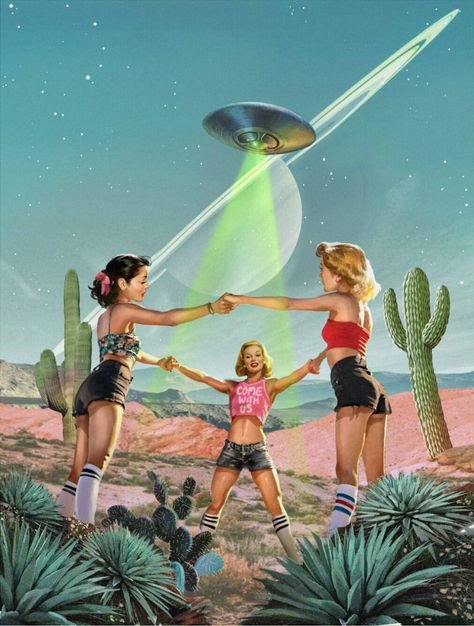Text

Nana Visitor on "MacGyver" (1985)
147 notes
·
View notes
Text
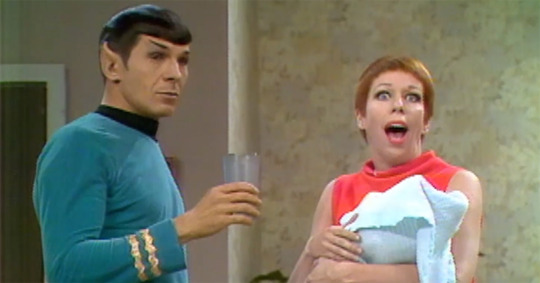
Spock guest-starred on the Carol Burnett Show, 1967.
233 notes
·
View notes
Text

The Council of Doom, who assembled to destroy Space Ghost. They include: Zorak, Creature King, Metallus, Moltar, Brak (but strangely, not his partner, Sisto - presumably they had an off-air falling out), and the Spider Woman, who conspired to imprison and destroy their mutual archenemy.


218 notes
·
View notes
Text
Because she was an intentionally mysterious woman initially only seen in a single episode, and before she got an on-air backstory in the recent streaming series, Star Trek supplementary material developed contradictory information on who - or what - Number One, the female first executive officer of the Enterprise, was. To my count, she has four different, completely incompatible backstories in the comics and novels, and this is absolutely unique in Star Trek, which usually keeps it consistent.

Peter David, in his New Frontier novels, identified Number One as a long lived immortal human mutant (like Flint from the original series) named “Morgan Primus” who was an early genius in cybernetics and artificial intelligence, which is why the Enterprise computer has her voice. One of the names Morgan Primus assumed to hide her immortality was Morgan Lefler, and one of her daughters was Robin Lefler, Wesley Crusher’s love interest from the Next Generation Series played by Ashley Judd. Robin Lefler did not inherit her mutant ability to heal all injuries.
Alternatively, the DC Star Trek Comics of the early 1980s said that Number One was from an obscure planet of peaceful, open, friendly telepaths who resemble humans exactly, and that she was present at first contact with Starfleet. They explained that her blunt, direct, undiplomatic manner is due to her being from a telepathic culture that values total honesty. This would make her the first telepath on the Enterprise, with Spock and Arex coming later. Her planet was created before the Next Generation, but her species being a peaceful, open, telepathic race resembling Mediterranean humans who are not well known or commonly encountered in the original series era….well, that certainly sounds an awful lot like Betazoids to me. If this backstory is true, she may have been the first Betazoid seen on screen, in much the same way fans generally believe Trelane was either Q or a member of the Q Continuum.
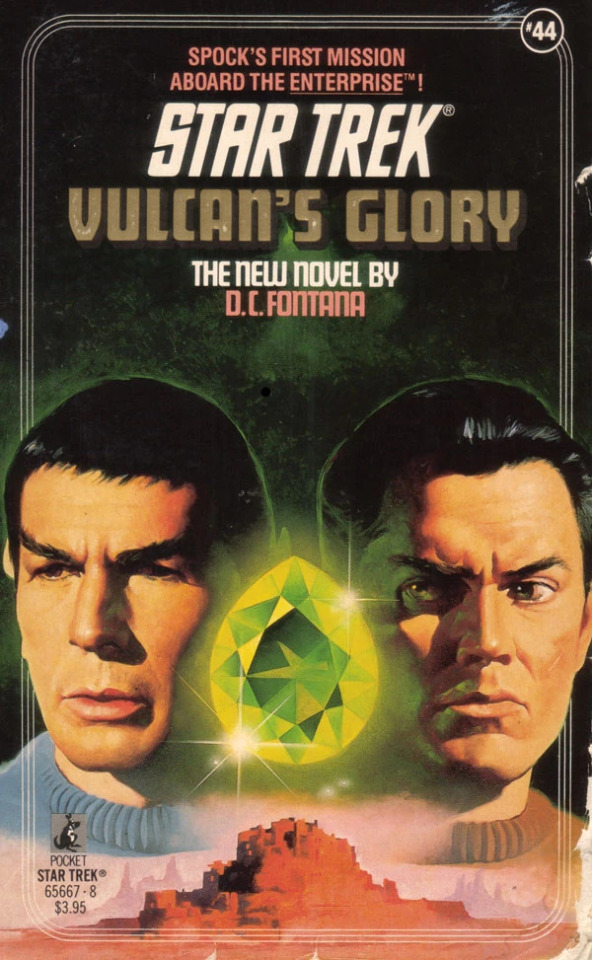
D.C. Fontana’s only Star Trek novel, “Vulcan’s Glory,” was one of the earliest attempts to give the character a backstory, and was the most consequential long term. The first novel set in the era of the first Star Trek pilot with Captain Pike and a young Spock, "Vulcan's Glory" identified Number One as being an Illyrian, a race of human-like beings who specialize in species wide breeding programs and genetic improvement. This genetic superiority is why she was cool, intellectual, aloof, and a bit arrogant. Her nickname “Number One” came from the fact she was the supreme product of the hyper-competitive Illyrian system, and won at everything from academics to athletics. According to DC Fontana, her actual Illyrian name is impossible to pronounce, so when dealing with humans, she assumed the human name “Una Chin-Riley.” Una of course, being “Number One” in Greek.

As DC Fontana is such an important figure in Star Trek history and only actually wrote one Star Trek novel in her life, many future materials used the backstory established in “Vulcan’s Glory,” like the David Stern Pike-era novels of the 2010s....but more importantly, the Discovery and Strange New Worlds series, which canonized the “Una Chin-Reilly” name by using it on screen (I remember gasping when Pike called her Una in a Discovery episode, meaning they were going with the Fontana backstory, a detail that may not have been significant to the casual viewer). Since DC Fontana wrote “Vulcan’s Glory” in the 80s, a lot more information was learned about the role of genetic engineering in the Federation, however, and interesting things were done in that series to bring her in line with everything we’ve learned since in Deep Space 9 and Enterprise about augmentation and the society wide prejudice against it. For example, they established that the fact Number One was Illyrian was not public knowledge, but that she pretended to be human her entire life.

The one person who didn’t see fit to give her a backstory or even a real name was John "Johnny Redbeard" Byrne in his comic series about the Cage era Enterprise, who thought the mystery of the character was the most interesting thing about her, and he was deliberately cagey about any details. To Johnny Redbeard, she was just “Number One.” There was a running joke that every time someone says her actual name, or when we see her personnel file, it was blurred out, or somebody’s thumb was over it, and so on. It was rather like the running joke where Mr. Burns never remembers Homer Simpson's name. Johnny Redbeard loves mystery men and women who don't talk about their past, since that was the characterization he famously gave to Wolverine in his X-Men comics.


The one detail of Number One's past that is clear is that Number One in Byrne's comics is competent, mysterious, and has mystique, certainly, but she is completely human, without any powers. Byrne always got exasperated that his X-Men co-creator Chris Claremont added fantastical and far out details to the background of X-Men characters (like how Nightcrawler's girlfriend Amanda turned out to be a sorceress) because he felt "some people should just be allowed to be normal." Byrne always said his original idea for Wolverine's "true" backstory was that he was a Vietnam veteran in intelligence who volunteered for bionic experiments that wiped his memory, and disliked the idea he was immortal, and vetoed the very, very early Dave Cockrum idea Wolverine was an actual mutated wolverine who achieved sentience and a human shape (which early X-Men comics hint at). Byrne was reportedly enraged that they gave Moira MacTaggart a mutant power, as he saw her as just being a scrappy Scottish housekeeper.

Johnny Redbeard didn’t give Number One a past (other than to show she was on the Enterprise's shakedown cruise with Robert April as a rookie officer), but he did give her a future, as he showed an older Number One as a starship commander in the Kirk era (aging gracefully with a white tuft like Tongolele), and later, a flag officer in the Motion Picture era.

To what extent are these backstories compatible? Well, with what we currently know about Number One, that she hid her true species and status to avoid prejudice, it could be that some of the other versions were tall tales she spread to obscure her true origins. The John Byrne idea she served as an Ensign with Robert April in the Enterprise's very first mission hasn't been confirmed, but hasn't been denied, either. The Peter David "Morgan Primus" backstory is completely incompatible, but perhaps there are some elements to it that are true, like the idea that the early part of her career involved working as a computer engineer in artificial intelligence, which is why the computer has her voice.
438 notes
·
View notes
Text

David Gerrold's "When HARLIE Was One" (1972) was a novel about an artificial intelligent computer, and his friendship with his psychologist. It is chiefly remembered as being the origin of the idea of a "computer virus," which the novel predicted a decade before an actual computer virus came into existence.
HARLIE showed up in other David Gerrold novels, notably Star Wolf, where every intergalactic cruiser had a HARLIE installed. A HARLIE (not necessarily the HARLIE) showed up in Gerrold's War Against the Cthorr novels.
237 notes
·
View notes
Text
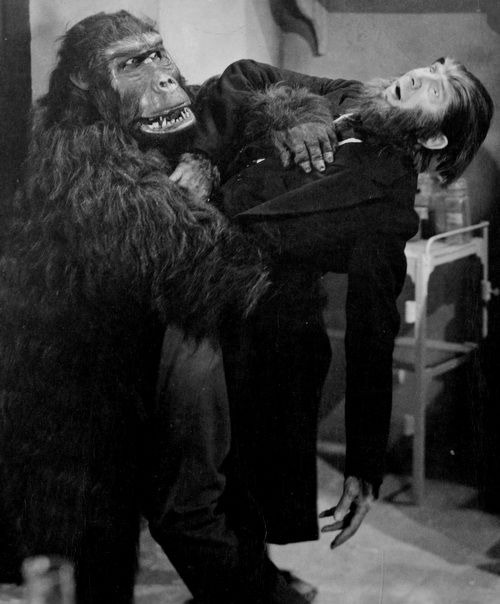
"Ape Man" (1943)
80 notes
·
View notes
Text

"Hercules" (1983).
257 notes
·
View notes
Text
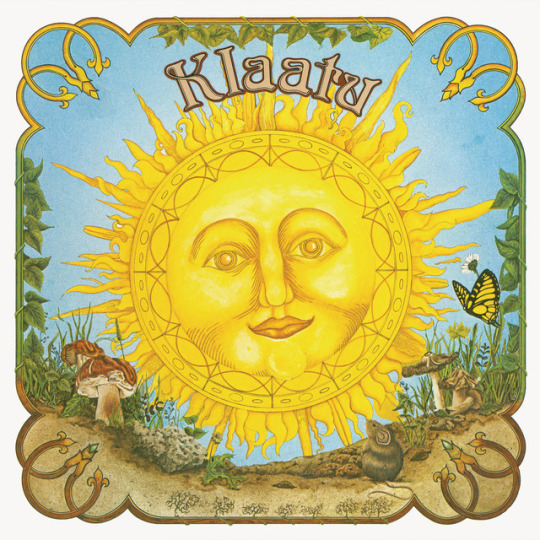
The 1970s progressive pop band Klaatu was known not just for their futuristic iconography, with songs like "Calling Occupant of Interplanetary Craft (The Recognized Anthem of World Contact Day)" but for a very, very strange rumor in the mid-70s, that Klaatu were secretly the Beatles (or at least some of the Beatles), who reunited in disguise.
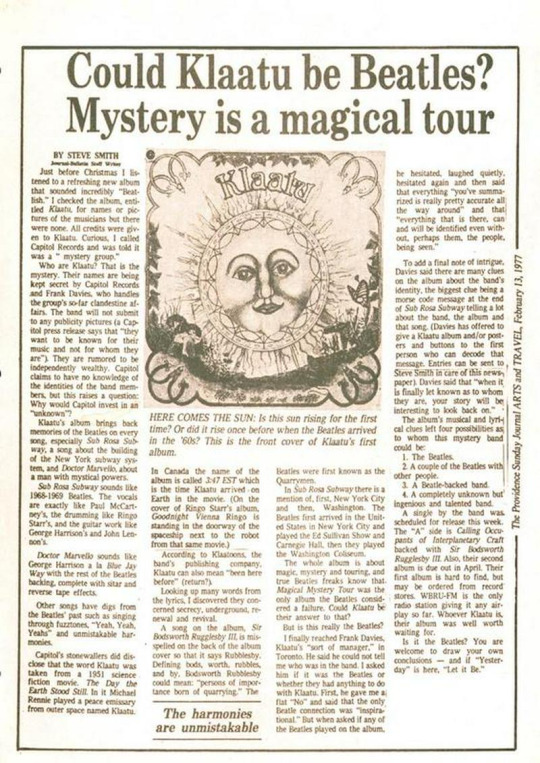
Why did people think this? Well Klaatu's name is a Day the Earth Stood Still reference, a movie the Beatles themselves referenced in songs like "Goodnight Vienna." It was also on EMI, which was the Beatles' label. The sun-symbol on their albums is reminiscent of Abby Road.
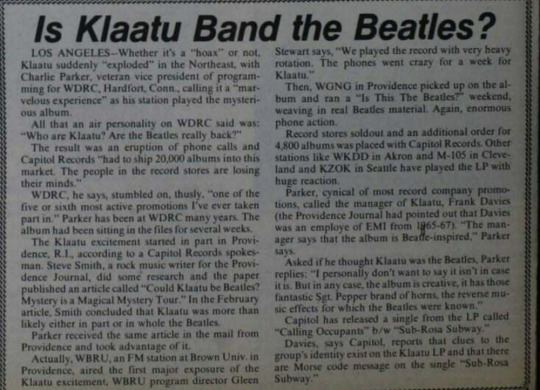
And most surprisingly of all, there were, suspiciously, no existing photographs of Klaatu at all, so nobody knew what they looked like. In reality, the reason there were no photographs was actually because Klaatu were just a random bunch of guys from Toronto, and there was no reason to include their images when they wanted the music to speak for itself.

The absence of photographs of the band isn't the entire reason people thought Klaatu were secretly the Beatles, though. Klaatu also sounded like many think the Beatles would, if they had continued making music, with a sort of surreal Electric Light Orchestra acid pop vibe, synth mixed with instruments like harpsichord. If you close your eyes and listen to "Sub Rosa Highway," the vocals are shockingly similar to Paul McCartney. On several occasions during the 1970s, John Lennon was asked what the Beatles would sound like if they stayed together, and the answer was something very much like the Electric Light Orchestra...and Klaatu sounds more like ELO than any other band.
When Klaatu got a sales bump because of the rumors they were the Beatles, their solution was extremely savvy: they initially refused to deny it. Ultimately, though, the band believes the rumors did them "more harm than good," as how could they live up to those expectations of being the Beatles?
248 notes
·
View notes
Text

Badge for Challenge of the Yukon, a 1936 sister radio show of Detroit radio's famous Lone Ranger and Green Hornet.
92 notes
·
View notes
Text
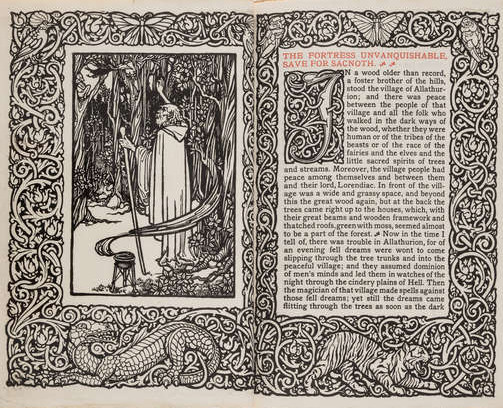
In 1908, early Fantasy fiction pioneer and chessmaster Lord Dunsany published his best story, "The Fortress Unvanquishable, Save for Sacnoth."
Arriving on the tail of a recently arrived comet, the evil sorcerer Gaznak raised his impossible fortress. The only way to get through it is with the sword Sacnoth, which can only be obtained by killing the dragon-crocodile Tharagavverug in the swamps surrounding it. The hero ventures into the impossible fortress, and the mere name of the sword Sacnoth is usually enough to make the wizard Gaznak's forces, like camel-riding warriors and undead women, recoil.

Many historians, like Fritz Leiber, call "The Fortress Unvanquishable, Save for Sacnoth" to be the first Sword & Sorcery story ever written.
233 notes
·
View notes
Text


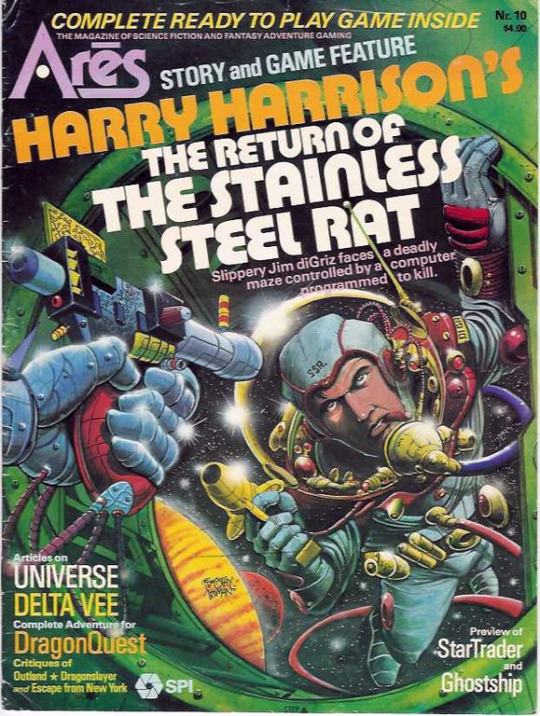
"Ares" was a magazine put out between 1977-1984 by SPI that specialized in military wargames with a fantasy or science fiction bent. It was put out by SPI, who mainly made military wargaming guides of the usual type, e.g. recreating Caesar vs. the Gauls or World War Ii, but they noticed the incredibly popular rise of strategic scifi starship board games like Phil Pritchard's Lensman in 1969, and Starforce: Interstellar Conflict in the 25th Century in 1974.
The key trait of Ares is that each issue came with a strategy game inside of it, with an expandable fold out map you get by lifting the staples, and with small unit counters on cardboard placed inside you punch out. So for example, the issue of Albion would fold out into this:


There used to be a lot of interstellar space strategy board games that in terms of complexity, had borders blurred with tabletop RPGs; even Star Trek got one under FASA. The main reason these kinds of games went away is that they never had a huge audience due to their simulative complexity. Their audience was a sort of hodgepodge of Gifted Kids and ex-military veterans, and that audience fractured. Gifted Kids went on to tabletop RPGs and video games, particularly when, in the late 80s, home computers became able to do the kind of complex number heavy games of this nature.
Most issues of Ares are available from the Internet Archive, and with some creativity and cardboard, you can even print miniatures.
140 notes
·
View notes
Text
"The Ayla Descent Theory" of Mary Sues
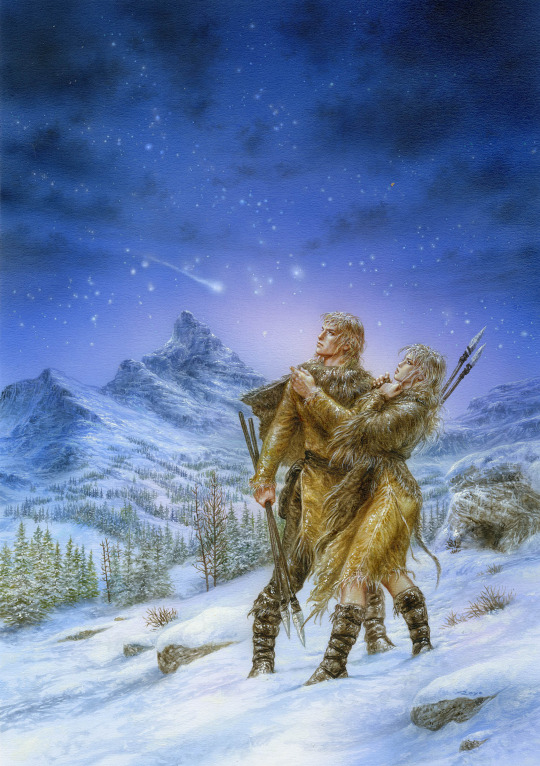
"Children of the Earth," Luis Royo.
After the success of Jean M. Auel's stone age novel Clan of the Cave Bear, there was a very lengthy trend in the publishing world of stone age adventure novels aimed at women that lasted for a decade and only really fizzled out in the early 2000s. After all, "Ayla," the name of the main character of these books, was one of the top baby names of 1987.
The target audience for these books were weird midwestern aunts....you know, the Mists of Avalon and the Mercedes Lackey/Valdemar audience. Therefore, the Clan of the Cave Bear imitators also featured things of interest to the weird aunt audience: Scotland, redhaired women with sharp tongues, commanding wolves, Ireland, Feminism, riding herds of wild horses bareback in scenic locations, Wicca, matriarchial religions, swimming with dolphins....but above all else, American Indians (a culture this audience finds interesting, as anyone who has seen the home decor of a typical weird midwestern aunt can attest), with many novels set in Ice Age America, like Children of the Dawn, Reindeer Moon and the First Americans. Decades later, this audience would form the core fandom for Game of Thrones, and the character of Khaleesi Targaryen in particular.

These books almost assuredly still have a place of honor on the book shelf of the weirdest woman at your job.
Nearly all of these imitators have two of Clan of the Cave Bear's defining traits: 1) a supremely beautiful, usually blonde athletic and statuesque main character over 5'11" who does not realize that she is so beautiful and desirable, who is good at a variety of different skills and is friendly with animals like hawks, dolphins, or horses, and 2) a love triangle between this aforementioned blond but innocent Venus and two bodybuilder muscular he-men cave hunks, one of whom is a blonde guy with long rock star hair (it was the 80s), and the other being a buff black guy with dreadlocks (or otherwise ethnic in some way).
The heroine usually picks the blonde guy in the end, but the audience usually picks the ethnic guy.

In the late 90s and early 2000s, in the broader culture of fandom, it was fashionable to dump on "Mary Sues" (indulgent wish-fulfillment author personas in fanfiction) and the people who wrote them. Accusations of creating a Mary Sue approached a kind of hysteria. Even at the time, when everyone else was getting swept up in this, I thought that getting mad about aunties writing fanfiction showed a loss of perspective, and was a bit silly. Thankfully, we've benefitted from moral evolution: the consensus in fandom now is that writing aspirational characters is a harmless activity that tests a young writer's creative muscles, like the half-Vulcan pretty new ensign on the Enterprise that Kirk and Spock both fall in love with, or a new archer girl who Legolas falls in love with joining the Fellowship. This hate walked hand in hand with insecurities, in the exact same way that people worried about their appearance or concerned with their weight are often cruel to fat people, and there were frequent tests if this or that character in your writing was a Mary Sue.

There was a running joke in this 2000s culture of anti-self insertion called the "Ayla Descent Theory of Mary Sues." The joke was that Mary Sues came into existence because Ayla, the beautiful, athletic heroine of the Clan of the Cave Bear novels, was the ancestor of their entire lineage, as the first known Mary Sue to ever exist in the historical record, described as being a statuesque blonde who did everything right and was always at the center of love triangles, and who changed human history.
According to the running joke, Mary Sues everywhere were descended from Ayla from Clan of the Cave Bear, and she was the first to exist, and Ayla was the explanation of where all the Enterprise's new ensigns main characters fall in love with come from.
404 notes
·
View notes
Text
The Evil Little Hairy Cave People of Europe in Pulp Fiction

From the 1900s to the 1940s, there was a trendy theme in occult and horror stories that the explanation for widespread European legends of fairies, brownies, pixies, leprechauns and other malicious little people, was that they were a hereditary racial memory of the extremely small non-human, hairy stone age original inhabitants of Europe, who still survive well into modern times in caves and barrows below the earth. Envious of being displaced on the surface, these weird creatures, adapted to the darkness of living underground and unable to withstand the sun, still mean mischief and occasionally go out at night to capture someone.... usually an attractive woman....to take to their dark caves for human sacrifice.
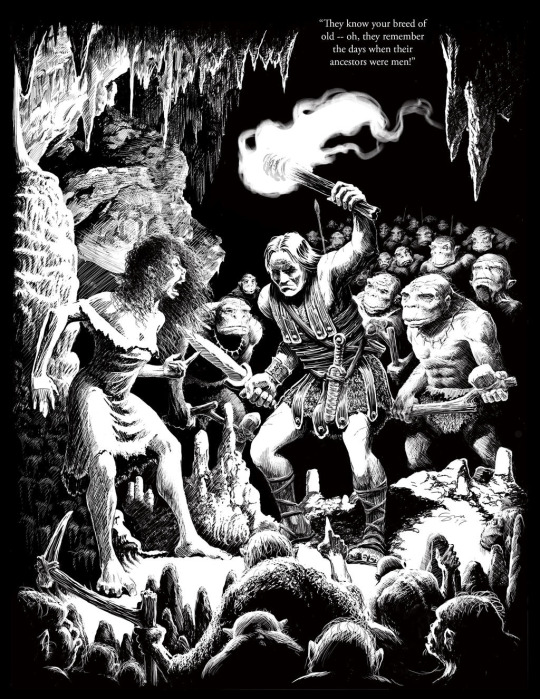
Displaced by the arrival of Indo-European language speakers at the dawn of the Bronze Age, these original, not quite human stone age people of Europe were driven deep underground into caves and barrows below the earth, where they went mad, adapted to the darkness and acquired a fear of daylight, became extremely inbred, in some cases acquired widespread albinism. It is these strange little people who gave the descendants of Europeans a haunting racial dread of places below the earth like mines and caves, and it also is these strange, hairy troglodytes who originally built the uncanny and mysterious menhir, fairy rings, and stone age structures of England, Scotland, and Ireland that predate the coming of the Celts and Romans.
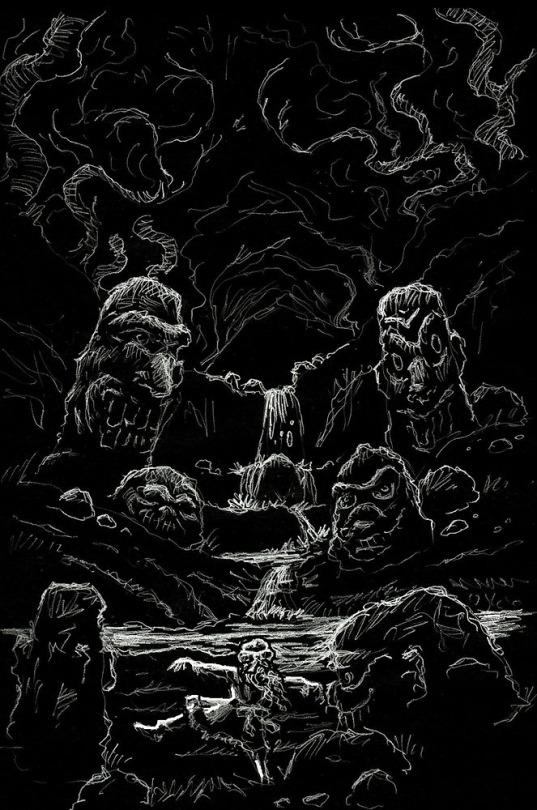
In some cases, these evil troglodytes are usually identified with the mysterious Picts, the pre-Celtic stone age inhabitants of the British Isles. In some cases, they are identified with the Basque people of Spain, best known as the inventors of Jai Alai, and the oldest people in Europe who speak a unique language unrelated to any in the world.
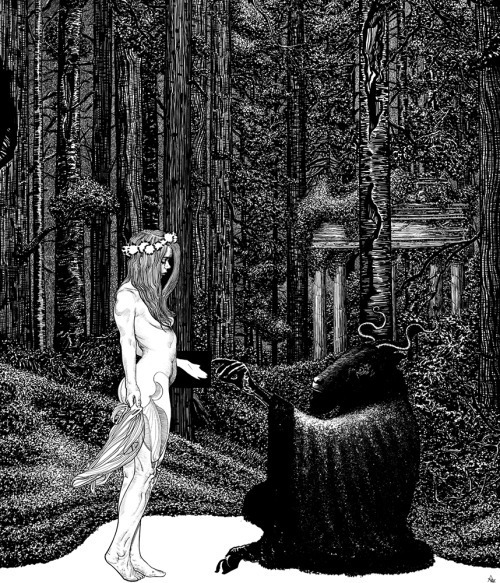
The original codifier of this trend was Arthur Machen, a horror writer who is less remembered than his contemporary, Henry James, but who may be the best horror writer in the generations between Poe on the one end and Lovecraft/CL Moore/Clark Ashton Smith on the other. His story, "the White People" from 1904 (a reference to their strange cave albinism) was a twisted Alice in Wonderland with a girl who is irresistibly attracted to dark pre-Roman stone age ruins and who is eventually pulled underground.
In addition to being a great horror writer, Arthur Machen was a member of the Hermetic Society of the Golden Dawn, an occult organization, and was often seen at the Isis-Urania Temple in London. Many of his works have secretive occult knowledge.
H.P. Lovecraft in particular always pointed out Arthur Machen as his single biggest inspiration, though he combined Machen's dread and occultism with Abraham Merritt's sense of fear of the cosmic unknown, seen in "Dwellers in the Mirage" and "People of the Pit."

Another and scarier example of this trend would be "No Man's Land," a story by John Buchan, a Scotsman fascinated by paganism and horror, who often wrote stories of horrific discoveries and evil rites on the Scottish moors. He is often reduced to being described as a "Scottish Ghost Story" writer, a painfully reductivist description as in his career, Buchan wrote a lot of thrillers, detective, and adventure stories as well. In later life, he was appointed Governor General of Canada, meaning he may be the first head of state to be a horror writer.
It was Buchan who first identified the cave creatures with the Picts, something that another Weird Tales writer decades later, Robert E. Howard, would roll with in the 1920s.

Howard is a very identifiable kind of modern person you often see on the internet: a guy who talks tough, but who was terrified to leave his small town. He created manly man, tough guy heroes like Conan the Barbarian, Kull, and El Borak, but he himself never left his mother's house. It's no wonder he got along well with his fellow Weird Tales writer and weird shut in, HP Lovecraft. With 1920s Weird Tales writers, despite your admiration for their incredible talent, you also can't help but laugh at them a little, a feeling you also apply to a lot of Victorians, who achieved incredible things, but who are often closet cases and cranks who died virgins ("Chinese" Gordon comes to mind, as does Immelmann).
With Howard, his obsession with the Picts and the stone age cave dwelling people of Europe started with an unpublished manuscript where at a dinner party, a man gets knocked out and regresses to his past life in the Bronze Age, where he remembers the earliest contact between modern humans and the original inhabitants of the British Isles, the evil darkskinned Picts. This is a mix of both the "little cave people" story and another cliche at the time, "the stone age past life regression novel," another turn of the century cliche.
Still with the Picts on his mind, Howard would later create Bran Mak Morn, a Pict chieftain, who predated Kull and Conan as his Celtic caveman muscle hero. Howard was of Irish descent and proudly anti-Colonial and anti-British, with his Roman Empire and Civilized Kingdoms as a stand in for the British and other Empires, which he viewed as rapacious and humbug, a view shared by his greatest inspiration, Talbot Mundy. His "Worms of the Earth" gets to the heart of why these little cave people scare us so much: they remind us that we live on land that is impossibly ancient and we don't fully understand at all.
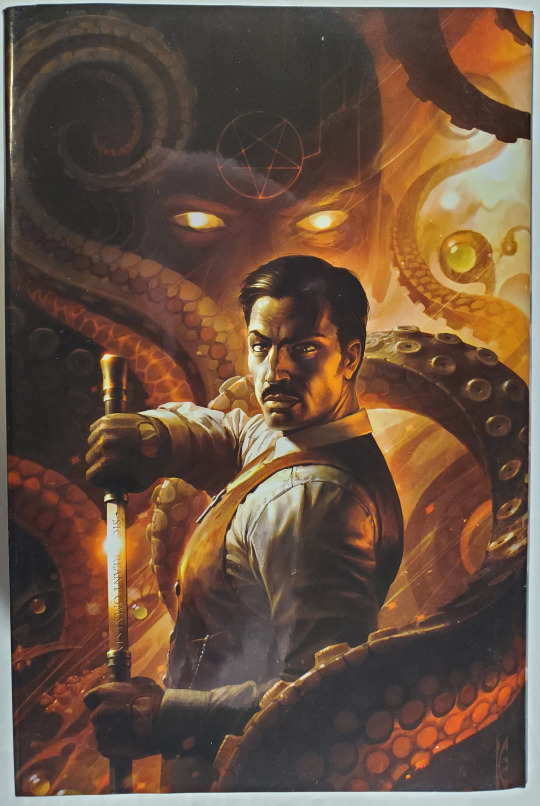
It was another Weird Tales Writer a decade later who wrote one of the last stories about the little hairy cave people of Europe, though, Manly Wade Wellman in 1942. Wellman was mainly known for creating the blond beefcake caveman hero Hok the Mighty set in stone age times, and for his supernatural ghost stories of Silver John the Balladeer set in modern, ghostly Appalachia (like many ex-Weird Tales writers, he made a turn to being a regional author in his later career, in the same way Hugh B. Cave became a Caribbean writer), but Wellman also had a regular character known as John Thunstone, a muscular and wealthy playboy known for his moustache who used his great wealth to investigate the supernatural and the occult. Thunstone had a silver sword made by St. Dunstan, patron of Silversmiths, well known for his confrontations with the Devil.
Most John Thunstone stories featured familiar stories, like a demon possessed seance and so on, but one in particular featured a unique enemy, the Shonokins.
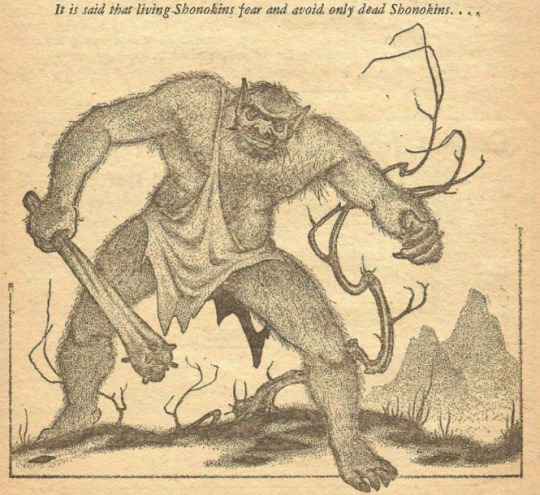
The Shonokins were the original rulers of North America, descendants of Neanderthal man displaced by American Indians. This fear that the land we live is ancient and unknowable and we just arrived on it and don't know any of its secrets is common to settler societies, who often hold the landscape with dread, as in Patricia Wrightson's fantasies of the Australian Outback. It was easy enough to transport the hairy cave people from the Scottish Moors to North America. I suspect that's what they are, a personification of a fear shared in the middle class, that in the back of their minds, that everything they have supposedly earned is merely an accident of history, built by rapacity and the crimes of history, and that someday a bill will come due.
A text page in the May 1942 issue of Weird Tales gives strange additional information on the Shonokins not found elsewhere:
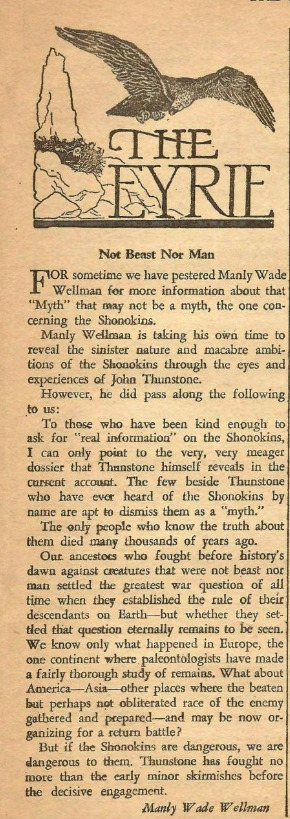
Since then, there have been too many examples of evil cave people who predate Europeans. Philip Jose Farmer's "The All White Elf" features the last survivor of a pre-European people who live in caves. A lot of other fiction of course has featured the Picts, but according to our modern scientific understanding, which describes them as much, much less exotically, as a blue tattooed people not too different and practically indistinguishable from the Celtic tribes that surrounded them, and which they eventually blended into.
411 notes
·
View notes
Text

John Pertwee safety PSA for SPLINK.
SPLINK is an acronym that stands for
(First find a) Safe (place to cross, then stop)
(Stand on the) Pavement (near the kerb)
Look (all round for traffic and listen)
If (traffic is coming, let it pass)
(When there is) No (traffic near, walk straight across the road)
Keep (looking and listening for traffic while you cross).'
Because of the extreme awkwardness of this impossible to remember acronym, it is generally considered to be one of the worst PSA campaigns of all time, and is frequently parodied in British media.
473 notes
·
View notes

